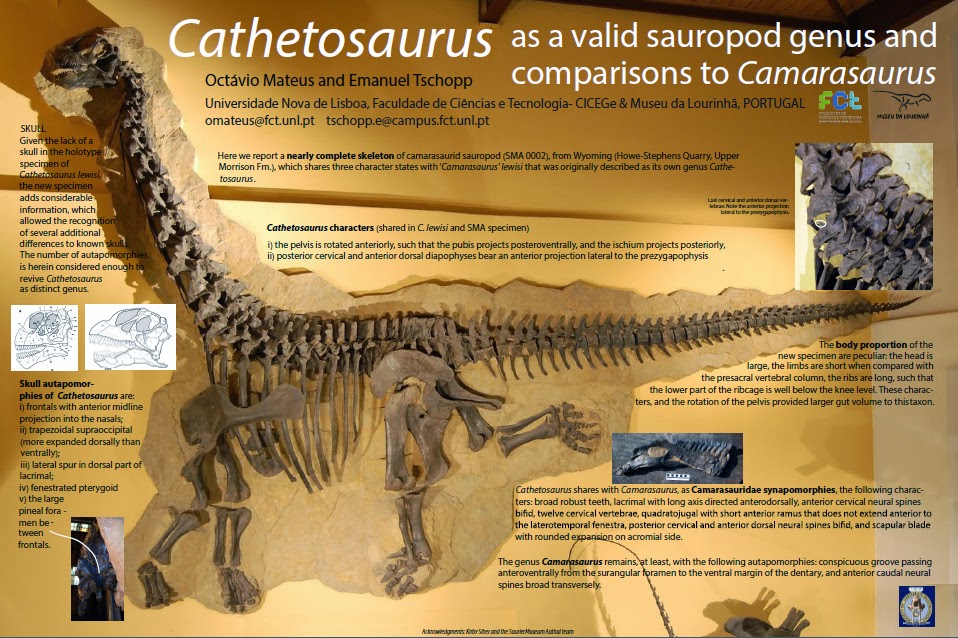O ano passado reportámos um espécime de Cathetosaurus do Jurássico Superior de Wyoming, Estados Unidos. Este espécime SMA002, previamente classificado como Camarasaurus, é agora visto como Cathetosaurus lewisi e permitiu finalmente uma clara distinção entre estes dois géneros de dinossauros saurópodes.
Referência:
Mateus, O., & Tschopp E. (2013). Cathetosaurus as a valid sauropod genus and comparisons with Camarasaurus. Journal of Vertebrate Paleontology, Program and Abstracts, 2013. 173.
 |
| The sauropod Cathetosaurus lewisi SMA 002. Poster by Mateus and Tschopp (2013) |
Referência:
Mateus, O., & Tschopp E. (2013). Cathetosaurus as a valid sauropod genus and comparisons with Camarasaurus. Journal of Vertebrate Paleontology, Program and Abstracts, 2013. 173.
PDF
Abstract:
Here we report a nearly complete camarasaurid sauropod from Wyoming (Howe-Stephens Quarry, Upper Morrison Formation), which shares three character states with Camarasaurus lewisi that was originally described as its own genus, Cathetosaurus. The shared states are the following, and are not present to the same degree in other Camarasaurus species: i) the pelvis is rotated anteriorly, such that the pubis projects posteroventrally, and the ischium projects posteriorly, ii) lateroventrally projecting spurs in the neural spines of the last dorsals; iii) posterior cervical and anterior dorsal diapophyses bearing an anterior projection lateral to the prezygapophysis.
Given the lack of a skull in the holotype specimen of Cathetosaurus lewisi, the new specimen (Sauriermuseum Aathal specimen SMA 0002) adds considerable information, which allows the recognition of several additional differences to known skulls. The number of autapomorphies is herein considered enough to revive Cathetosaurus as a genus distinct from Camarasaurus. Additional skull autapomorphies of Cathetosaurus are: i) frontals with anterior midline projection into the nasals; ii) trapezoidal supraoccipital (more expanded dorsally than ventrally), iii) lateral spur on the dorsal part of the lacrimal, iv) fenestrated pterygoid; and v) the large pineal foramen between the frontals.
Cathetosaurus shares with Camarasaurus (as camarasaurid synapomorphies) the following characters: broad robust teeth, lacrimal with long axis directed anterodorsally, anterior cervical neural spines bifid, twelve cervical vertebrae, quadratojugal with short anterior ramus that does not extend anterior to the laterotemporal fenestra, posterior cervical and anterior dorsal neural spines bifid, and scapular blade with rounded expansion on the acromial side.
The genus Camarasaurus remains, at least, with the following autapomorphies: conspicuous groove passing anteroventrally from the surangular foramen to the ventral margin of the dentary, and anterior caudal neural spines broad transversely.
The body proportions of the new specimen are peculiar: the head is large, the limbs are short when compared with the presacral vertebral column, the ribs are long, such that the lower part of the ribcage is well below the knee level. These characters, and the rotation of the pelvis provided larger gut volume to this taxon.
Abstract:
Here we report a nearly complete camarasaurid sauropod from Wyoming (Howe-Stephens Quarry, Upper Morrison Formation), which shares three character states with Camarasaurus lewisi that was originally described as its own genus, Cathetosaurus. The shared states are the following, and are not present to the same degree in other Camarasaurus species: i) the pelvis is rotated anteriorly, such that the pubis projects posteroventrally, and the ischium projects posteriorly, ii) lateroventrally projecting spurs in the neural spines of the last dorsals; iii) posterior cervical and anterior dorsal diapophyses bearing an anterior projection lateral to the prezygapophysis.
Given the lack of a skull in the holotype specimen of Cathetosaurus lewisi, the new specimen (Sauriermuseum Aathal specimen SMA 0002) adds considerable information, which allows the recognition of several additional differences to known skulls. The number of autapomorphies is herein considered enough to revive Cathetosaurus as a genus distinct from Camarasaurus. Additional skull autapomorphies of Cathetosaurus are: i) frontals with anterior midline projection into the nasals; ii) trapezoidal supraoccipital (more expanded dorsally than ventrally), iii) lateral spur on the dorsal part of the lacrimal, iv) fenestrated pterygoid; and v) the large pineal foramen between the frontals.
Cathetosaurus shares with Camarasaurus (as camarasaurid synapomorphies) the following characters: broad robust teeth, lacrimal with long axis directed anterodorsally, anterior cervical neural spines bifid, twelve cervical vertebrae, quadratojugal with short anterior ramus that does not extend anterior to the laterotemporal fenestra, posterior cervical and anterior dorsal neural spines bifid, and scapular blade with rounded expansion on the acromial side.
The genus Camarasaurus remains, at least, with the following autapomorphies: conspicuous groove passing anteroventrally from the surangular foramen to the ventral margin of the dentary, and anterior caudal neural spines broad transversely.
The body proportions of the new specimen are peculiar: the head is large, the limbs are short when compared with the presacral vertebral column, the ribs are long, such that the lower part of the ribcage is well below the knee level. These characters, and the rotation of the pelvis provided larger gut volume to this taxon.




Sem comentários:
Enviar um comentário